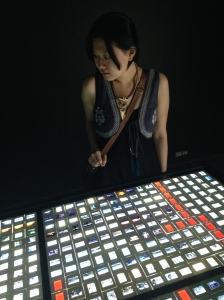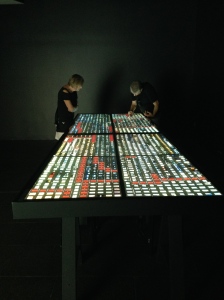1. Identify a work of art that you have enjoyed looking at. List: Artist name, title, date the work was created and country.
Is the artwork a:? What is the title of the exhibition this work is in? Who is the curator? Who is the owner?
The art work I enjoyed looking at is Phoung Ngo’s work, Look Past (2013), Australia. This work is part of Melbourne Now exhibition in the National Gallery of Victoria, which is a public art museum. There are more than twenty curators collaborating in this exhibition, including the NGV curator team and the guest curators.
These question will let students have basic information of artwork, and they can also compare the differences of works exhibited in different types of galleries or curated by people from different backgrounds.
2. How big is the artwork? What is the scale of the artwork in relationship to the human figure? How does it compare to you or the things around you? Do you need to stand or move in any particular way to view the work? Are there constraints on the viewer or is there an element of interactivity? How is the artwork lit?
The artwork is displayed on a custom size of light table that is as big as a dining table, and the height of this platform is close to the height of my waist. It is in the central of a dark room, and the light come out underneath the table. I need to stand and move around to view the sequences of 35 mm negative slides. There are two magnifiers on this light table so that viewers could use them to see more details on these negatives.
These question will allow students to explore the physicality of art work, how art work is installed and its relation to viewers and space.
3.What materials or media have been utilised in the creation of this artwork?What methods or applications have been applied?
The artist uses found film negatives from the period of Vietnam war to create his own narratives, displaying them on a light table; therefore, I think this work can be viewed as an installation.
4.List the things you can see in the artwork. For example; people, buildings, animals, shapes, colours and shapes. What are they doing? Is there a story?
In the collection of negative slides and photos, I can see American militaries, Vietnamese people, buildings, dogs and Vietnamese landscape. There are also some slides in red colour, I guess they are damaged negatives which shows the loss or missing in this story. People are doing their daily things in the war time, for example, American solider is sleeping with his gun or in training. The narrative aspect of this project is both historical and personal, and the story was also constructed by the artist.
5. How have the art elements been applied in this artwork? Comment on at least two. Colour, tone, texture, shape, form or line.
The colour of these slides are very film like, and the artist did not do anything with the dust and scratch on these negatives, so they become part of texture of this work.
6. How have the art principles been applied to this artwork? Comment on at least two. Composition, contrast, emphasis, unity, balance, movement, rhythm or pattern.
As they are found images/objects, so I feel quite hard to comment on images themselves. I do think the colours are quite contrasty from viewing them on the light table. and the same size slides are placed in lines to create a storyline.
Question four to six are designed for students to explore visual elements in art work; and how these elements are applied by artists.
7. What is the overall mood or emotional intent of the artwork? How does it make you feel? What has the artist done to make the viewer feel like this?
Artist shows the obsession of his own history; and how he views them in the artwork. I feel this work is very poetic and emotional, as the colour and tone of negative slides. I am also very engaged with the narratives artist created because all the negatives were displayed on the light table to let audience interpret them in their own orders.
This question is design for students to look at intention of artists, and the methodology artists use to evoke viewers.
8. Does this artwork refer to or remind you of any other artworks, art movements or artists? Has the artist appropriated anything from another source? What other artists or art movements might have inspired the artist? Does it remind you of anything else?
The work reminds me of Christian Boltanski’s work because they both deal with history, death and narratives. The artist also uses negative slides he has been collecting since 2009, and these photos look like being taken by a war photographer. There are a few artists I think may inspire the artist, for example, Jeff Wall and Clare Rae, using light boxes to present photographs; and also artist Tacita Dean’s uses negatives in her large scale of installation work Film.
9. Do some research about the artist to see what else you can learn about their art practice. Is this different to other work they have made or the same? Try to describe the difference?
The artist has been engaging with his Australian Vietnamese identity and the universal experience of loss and memories since one of his early shows My Life, Your Death at First Site Gallery in 2010. I think this work is more engaged with universal experiences, comparing to his earlier work.
Through answering question eight and nine, students can research about artists and gain a deeper understanding of artwork. Furthermore, comparing artists’ works, students can find out similarities and differences in their works, and examine mediums are used to express their ideas.
10. What issues, ideas or themes do you think the artist might be trying to raise in the artwork? What might the artist’s point of view be? What makes you think that? Do you have an opinion about it?
The artist explores not only his own identity – the son of Vietnamese refugees but also his collective identity as a member in the Vietnamese diaspora community. The artist creates his own narratives, and he also questions that the impact of an political event on people’s lives. In thousands of slides, I see fine details of ordinary people’s houses, the daily routine of unknown soldiers and even their pets through the magnifier, which evokes a feeling of sympathy and relates to my family experiences under a series of critical events in the past.
These questions will let students be more critical with artworks, and help them understand artworks better and relate them to their own experiences.
11. Write a bibliography
http://rightnow.org.au/topics/asylum-seekers/my-dad-the-people-smuggler-mid-week-review/
http://www.melbournereview.com.au/arts/article/my-dad-the-people-smuggler
http://www.ngv.vic.gov.au/melbournenow/artists/phuong-ngo
http://www.beamcontemporary.com.au/Clare-Rae-2011.html
http://www.moma.org/collection/artist.php?artist_id=649


